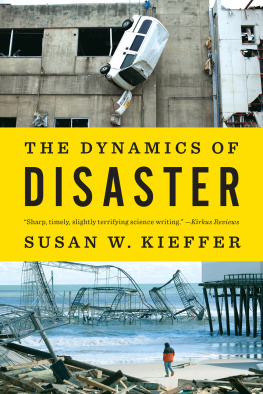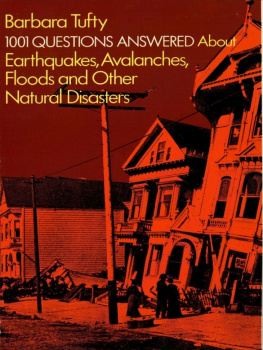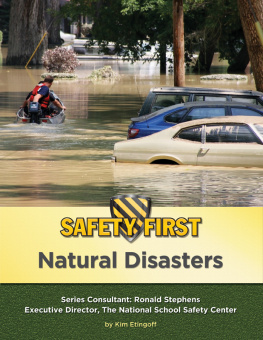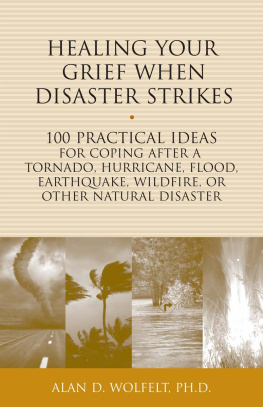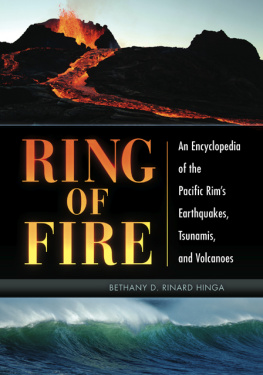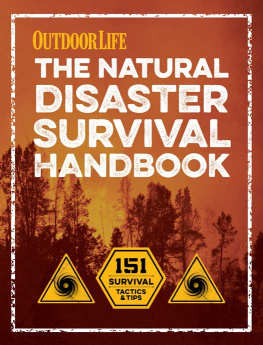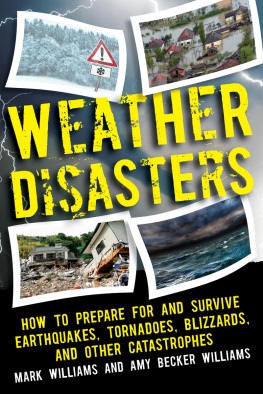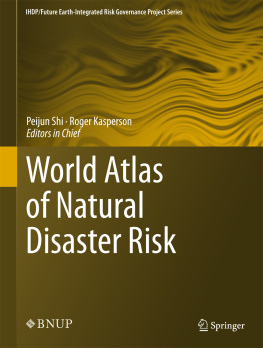
Geologist Kieffer analyzes recent earthquakes and eruptions with a clear eye on improving our planning for, and response to, these inevitable events.
Discover
This book ought to be placed in the hands of politicians, engineers, insurance assessors and, frankly, anyone who sees sense in understanding the processes and systems that guide our planet.
Geographical Magazine
The clarity of Kieffers writing, coupled with her careful choice of supporting graphics, makes the content engaging and accessible to a wide readership.
Times Higher Education
Kieffer takes a novel approach that involves thinking about natural catastrophes in terms of changes to systems that otherwise present no threat.
BBC Focus
[A] brisk and lucid presentation.
Times Literary Supplement
Safety professionals of all stripes would do well to read Kieffers fascinating, big-picture survey of some of the hazards that rumble across our churning, chaotic planet.
National Fire Protection Association Journal
Great earthquakes, immense landslides, enormous waves! Geologist Susan Kieffer calmly and clearly explains how and why such disasters are part of living on a dynamic planet. She shows that reality is more dramatic, and far more interesting, than any disaster movie.
Sean Carroll, author of Brave Genius and Remarkable Creatures

With deepest gratitude to my wise menE-an, Paul, Pete,
and Wardfor decades of intellectual nourishment
and
to my wonderful, supportive husband and fellow
adventurer, Jerry, who wondered why I was so fascinated
that bananas were US$6 per pound in Australia!
(Reader: the answer is in Chapter 9!)
CONTENTS
THE NATURE
OF DISASTER
THE WORD DISASTER MEANS A SUDDEN CALAMITOUS event bringing great damage, loss, or destruction. The word could have meaning in the absence of humans; for example, it could be used to describe the effect of a volcanic eruption on the atmosphere. However, without a human to judge whether that is a disaster for the atmosphere or not, that concept remains in the world of academic discourse.
Most commonly, the word disaster is used to describe losses and damages that humans experience, individually or collectively. It is a word that conjures up a collage of images, ranging from the seemingly calamitous loss of a first youthful love, to the profoundly devastating loss of hundreds to even hundreds of thousands of people in violent acts of nature or humans. The singular word disaster reflects a spectrum of individual disasters ranging from purely geological, such as a volcanic eruption, to purely human, such as purposeful or accidental detonation of a nuclear device. This book is about one form of disasterthat caused by the ongoing geological processes on our planetand the intersection of the processes that cause disaster with our human presence on the planet. In other words, this book is about the dynamics of disaster.
The geological processes of our planet affect us in good ways, by providing us the essentials for life, and in bad waysin disasters. In turn, we affect parts of Earth as well because all of its components are interconnected. In discussing disasters with a wide variety of people, I have found it useful to define two end members of the spectrum of disasters: natural disasters and stealth disasters. Natural disasters result from the ongoing geological processes on our planet and have typically been referred to as acts of God by the insurance industry. They often have a sudden onset and immediate consequences, such as an earthquake, hurricane, or volcanic eruption. Some natural disasters, such as those that are weather related, are increasingly affected by humans.
Stealth disasters, in contrast, are caused by humans but involve the natural systems that support us. They have a gradual onset but near-term consequences. Some examples of stealth disasters are climate change, desertification, loss of soils, collapse of aquifers that store water underground, and acidification of the oceans. Climate change is the best-publicized stealth disaster these days. While much has been written about the causes of climate change, including the impact of natural processes such as volcanic eruptions on climate, much less has been written about how climate changeor any other stealth disasteris likely to influence natural disasters. The notable exception is the expected impact of climate change on atmospheric disturbances, such as number and intensity of hurricanes. But stealth disasters, like climate change, canand are likely toinfluence other natural disasters. For example, the ongoing removal of ice from our polar regions that started at the end of the last ice age may affect the frequency and location of volcanic eruptions, the number and size of landslides, the operation of hot-water geothermal systems, the magnitude and frequency of river floods, and even the frequency and style of earthquakes.
If we are to understand possible future effects of humans on the planet and on natural disasters, we need to understand the basic geological dynamics of natural disasters. In the past, our general perception of Earth has been that natural disasters are acts of nature that affect us. Now, however, we need also to understand how human behavior might impact natural disasters. Within such a framework the impact of stealth events needs to be broadened beyond climate change to all disasters, not just weather-related events. For example, how does climate change influence not only the weather, but the frequency of landslides, earthquakes, and volcanic eruptions? How does desertification affect not only regional weather and climate in Africa, but the frequency and strength of hurricanes elsewhere around the planet? How do such changes affect other natural processes, such as earthquakes and volcanic eruptions, at great distances?
The framework presented in this book is that natural disasters result from changes of state in a system through modifications of its materials, energy, or both, and that by understanding what causes these changes of state, we can begin to understand the possible influence of stealth disasters on natural disasters. Changes of state arise in several different ways. The two most common ways are by modifications of the materials in a system, and by modifications of their conditions of motion. An earthquake might rip open the earth, sending out vibrations that shake the ground, turning soils to mush, triggering landslides, or generating tsunamis. A river might flood, causing destructive waves or washing away its own banks. Winds might perturb the state of the ocean and atmosphere, causing rogue waves that sink ships in the oceans or atmospheric waves that attack airplanes in the atmosphere. Changes of pressure in the atmosphere, in the weight of glaciers on Earths surface, and in temperature or the migration of fluids in Earths crust can cause instabilities that trigger geothermal or volcanic eruptions.
Once the change of state involved with a particular natural disaster is understood, we can begin to institute engineering and policy practices to minimize its impact on our lives and communities. How do we deal with common natural disasters, such as small or moderate earthquakes? How do we deal with bigger events that are rare and have a low probability of occurrence, but have very high human and economic consequences? Do we deal with these two cases in the same way? How do we balance our attention to natural disasters with attention to other issues in our personal and communal livespoverty, disease, hunger? And, perhaps most importantly for the scope of this book, how are natural disasters in the future going to compare with those of the past in impacting our lives on this ever-more-crowded planet? Is it possible that our sheer numbers will exacerbate the type and magnitude of natural disasters?
Next page
